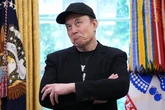As elections shake up governments around the globe and new politicians take the stage, we’re seeing just how powerful controlling the narrative has become in modern leadership.
“Leaders narrate strategy—they don’t just execute it,” said former New Labour communications strategist Alastair Campbell, the mastermind behind Tony Blair’s rise to power in the U.K. The most impactful leaders today are, without exception, master storytellers—just like the most successful politicians.
While crafting a compelling story has always been crucial for executives, today it’s the difference between success and failure.
In a business world defined by constant disruption, short-form media, relentless scrutiny, and internal upheaval, getting the narrative right is harder—and more essential—than ever.
With 89% of large companies currently involved in digital or AI transformation, leaders who shape a powerful change story dramatically improve their odds of success.
So how can leaders craft and control their narrative to drive the change they need? And what can business leaders learn from the world of politics?
Forge a cause that people can’t ignore
Donald Trump declared war on the “swamp of Washington.“ Bernie Sanders railed against the billionaire class “bandits.” Historically, leaders have often rallied their followers by choosing a common enemy, creating a burning platform for change. While this tactic still holds power, in 2024 leaders should also offer exhausted communities and colleagues a positive vision to move toward—not just something to move away from.
With high levels of talent disengagement, leaders must help define the meaning of work, building strong cultures that unlock discretionary energy in tough times. Research consistently shows that companies anchored by a positive vision or cause are significantly more effective.
Once you’ve defined your cause, it has to come to life in two critical ways. First, paint a picture so vivid that stakeholders can see, feel, and even smell it becoming real. Then, capture it in a sticky, singular rallying cry that resonates. Ronald Reagan’s “It’s Morning in America” is a powerful benchmark to strive for.
Don’t be scared to get emotional
Emotion is often dismissed in the boardroom, but Kamala Harris recently showed that the right emotion at the right moment can spark real followership. At the beginning of her presidential run, Harris was reported as “using joy to fuel her campaign” instead of engaging Trump on policy points.
Incorporating emotion into a narrative allows leaders to evoke those same feelings in others, boosting oxytocin and building trust. While joy may not be a strategy (as critics argue), emotions drive action—essential for any leader aiming to create the behavior changes needed to realize their vision.
Frame the hard truth within a game-changing vision
This year, many leaders will face tough decisions as they step into roles with a mandate for change. Balancing news of layoffs or restructuring while trying to build support is no easy task. Just ask U.K. Prime Minister Keir Starmer, who faced public backlash for tough budget cuts just weeks into office.
“It’s possible to do unpopular things and stay popular, as long as you provide a very clear sense of direction,” said Alastair Campbell.
When GM CEO Mary Barra had to make difficult decisions like plant closures, she consistently framed them within her broader vision for GM’s future. Her message—“We believe in an all-electric future”—positioned these tough choices as necessary steps toward innovation and sustainability, casting them as part of one of the most transformative periods in GM’s 115-year history.
Don’t just say it, live it
Ruthless repetition of vision and key messages has long been essential for making them stick. Just look at how often Trump’s team urged him to stay “on message.”
But repetition alone doesn’t cut it in today’s multi-channel world, spanning social media, internal communications, business press, and bloggers. These platforms are opportunities to bring your narrative to life through actions, not just words.
Spotify CEO Daniel Ek demonstrated this when he presented Spotify’s 2024 Q2 earnings via live video, rather than the traditional audio call, and followed up with short social videos on LinkedIn and Instagram. Ek’s approach embodied Spotify’s shift from a music streaming service to a broader platform for all types of audio content, including podcasts and video podcasts, aligning his behavior with the company’s evolving strategy.
Let others carry your story
Controlling the corporate narrative doesn’t mean only senior executives should speak on the company’s behalf.
Just as U.S. presidential candidates rely on surrogates to share and reshape their message, leaders can benefit from decentralized storytelling. This approach allows companies to cover more ground and have a presence in more spaces, while also creating a broader, more credible movement of support compared to traditional top-down messaging. More voices signal wider endorsement, much like the vocal support from Taylor Swift and others has fueled the momentum behind Kamala Harris’s campaign.
Airbnb CEO Brian Chesky embraced this by encouraging staff, hosts, and guests to own and share the “Belong Anywhere” story. From spotlighting host and guest voices in communications to launching the Host Awards, which celebrate those who go above and beyond, Chesky ensured the vision felt authentic and widely shared. TwentyFirstCenturyBrand’s CMO Thrive Guide has this advice for incoming leaders looking to do the same: Start by identifying your own surrogates. In every onboarding meeting, ask for three key people who can be trusted to champion your message—whether they’re domain experts or cultural standard-bearers.
To lead effectively in today’s rapidly changing world, mastering your narrative isn’t just an option—it’s a necessity. By forging a cause, tapping into emotion, and letting others carry your story, you can turn vision into action and inspire real change. Now is the time to step up, craft your story, and bring it to life through every decision, conversation, and action.
Sara Tate is European partner, Transformation Practice of TwentyFirstCenturyBrand.






No comments